
(a)
The indicated ratios in lowest fractional form.
Answer to Problem 19A
The ratio of dimension A to dimension B is
Explanation of Solution
Given:
The given figure is as follows:
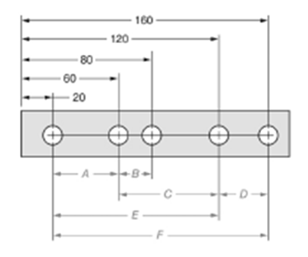
Concept used:
The dimension can be calculated by subtracting the distance of near hole from the one which is farther.
Calculation:
From the given figure, it is clear that the measure of dimension A is given by,
The measure of dimension B is given by,
The ratio of dimension A to dimension B is given by,
Thus, the ratio is
Conclusion:
The ratio of Dimension A to Dimension B is
(b)
The indicated ratios in lowest fractional form.
Answer to Problem 19A
The ratio of dimension A to dimension C is
Explanation of Solution
Given:
The given figure is as follows:
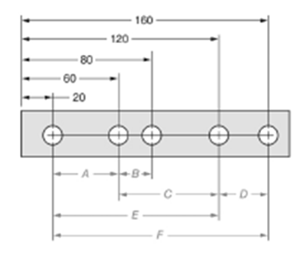
Concept used:
The dimension can be calculated by subtracting the distance of near hole from the one which is farther.
Calculation:
From the given figure, it is clear that the measure of dimension A is given by,
The measure of dimension C is given by,
The ratio of dimension A to dimension C is given by,
Thus, the ratio is
Conclusion:
The ratio of Dimension A to Dimension C is
(c)
The indicated ratios in lowest fractional form.
Answer to Problem 19A
The ratio of dimension C to dimension D is
Explanation of Solution
Given:
The given figure is as follows:

Concept used:
The dimension can be calculated by subtracting the distance of near hole from the one which is farther.
Calculation:
From the given figure, it is clear that the measure of dimension C is given by,
The measure of dimension D is given by,
The ratio of dimension C to dimension D is given by,
Thus, the ratio is
Conclusion:
The ratio of Dimension C to Dimension D is
(d)
The indicated ratios in lowest fractional form.
Answer to Problem 19A
The ratio of dimension C to dimension E is
Explanation of Solution
Given:
The given figure is as follows:
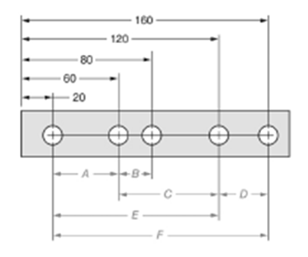
Concept used:
The dimension can be calculated by subtracting the distance of near hole from the one which is farther.
Calculation:
From the given figure, it is clear that the measure of dimension C is given by,
The measure of dimension E is given by,
The ratio of dimension C to dimension E is given by,
Thus, the ratio is
Conclusion:
The ratio of Dimension C to Dimension E is
(e)
The indicated ratios in lowest fractional form.
Answer to Problem 19A
The ratio of dimension D to dimension F is
Explanation of Solution
Given:
The given figure is as follows:
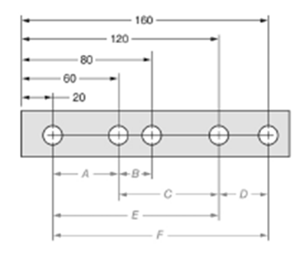
Concept used:
The dimension can be calculated by subtracting the distance of near hole from the one which is farther.
Calculation:
From the given figure, it is clear that the measure of dimension D is given by,
The measure of dimension F is given by,
The ratio of dimension D to dimension F is given by,
Thus, the ratio is
Conclusion:
The ratio of Dimension D to Dimension F is
(f)
The indicated ratios in lowest fractional form.
Answer to Problem 19A
The ratio of dimension F to dimension B is
Explanation of Solution
Given:
The given figure is as follows:
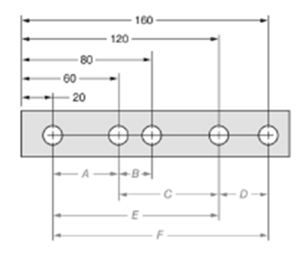
Concept used:
The dimension can be calculated by subtracting the distance of near hole from the one which is farther.
Calculation:
From the given figure, it is clear that the measure of dimension F is given by,
The measure of dimension B is given by,
The ratio of dimension F to dimension B is given by,
Thus, the ratio is
Conclusion:
The ratio of Dimension F to Dimension B is
(g)
The indicated ratios in lowest fractional form.
Answer to Problem 19A
The ratio of dimension F to dimension C is
Explanation of Solution
Given:
The given figure is as follows:
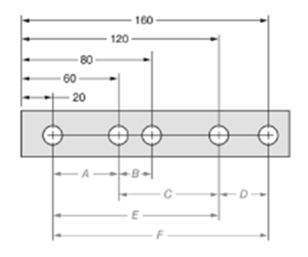
Concept used:
The dimension can be calculated by subtracting the distance of near hole from the one which is farther.
Calculation:
From the given figure, it is clear that the measure of dimension F is given by,
The measure of dimension C is given by,
The ratio of dimension F to dimension C is given by,
Thus, the ratio is
Conclusion:
The ratio of Dimension F to Dimension C is
(h)
The indicated ratios in lowest fractional form.
Answer to Problem 19A
The ratio of dimension E to dimension A is
Explanation of Solution
Given:
The given figure is as follows:
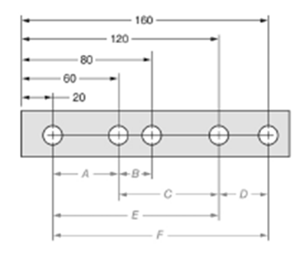
Concept used:
The dimension can be calculated by subtracting the distance of nearer hole from the one which is farther.
Calculation:
From the given figure, it is clear that the measure of dimension E is given by,
The measure of dimension A is given by,
The ratio of dimension E to dimension A is given by,
Thus, the ratio is
Conclusion:
The ratio of Dimension E to Dimension A is
(i)
The indicated ratios in lowest fractional form.
Answer to Problem 19A
The ratio of dimension D to dimension B is
Explanation of Solution
Given:
The given figure is as follows:

Concept used:
The dimension can be calculated by subtracting the distance the near hole from the one which is farther.
Calculation:
From the given figure, it is clear that the measure of dimension D is given by,
The measure of dimension B is given by,
The ratio of dimension D to dimension B is given by,
Thus, the ratio is
Conclusion:
The ratio of Dimension D to Dimension B is
(j)
The indicated ratios in lowest fractional form.
Answer to Problem 19A
The ratio of dimension C to dimension F is
Explanation of Solution
Given:
The given figure is as follows:
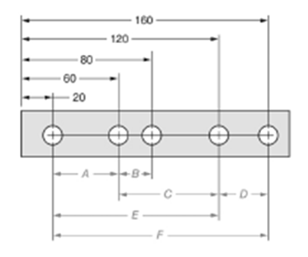
Concept used:
The dimension can be calculated by subtracting the distance of nearer hole from the one which is farther.
Calculation:
From the given figure, it is clear that the measure of dimension C is given by,
The measure of dimension F is given by,
The ratio of dimension C to dimension F is given by,
Thus, the ratio is
Conclusion:
The ratio of Dimension C to Dimension F is
Want to see more full solutions like this?
Chapter 20 Solutions
Mathematics For Machine Technology
- Remix 4. Direction Fields/Phase Portraits. Use the given direction fields to plot solution curves to each of the given initial value problems. (a) x = x+2y 1111 y = -3x+y with x(0) = 1, y(0) = -1 (b) Consider the initial value problem corresponding to the given phase portrait. x = y y' = 3x + 2y Draw two "straight line solutions" passing through (0,0) (c) Make guesses for the equations of the straight line solutions: y = ax.arrow_forwardIt was homeworkarrow_forwardNo chatgpt pls will upvotearrow_forward
- 18) Find all the complex cube roots of -2i. Leave your answers in polar form with the argument in degrees.arrow_forward9) Write an equation for the hyperbola. 2+ -6-5-4-3-2 -2- -4- -5+ + 23 45 6xarrow_forward8) Find an equation for the hyperbola with vertices at vertices at (±7, 0) and foci at (±9, 0).arrow_forward
 Mathematics For Machine TechnologyAdvanced MathISBN:9781337798310Author:Peterson, John.Publisher:Cengage Learning,
Mathematics For Machine TechnologyAdvanced MathISBN:9781337798310Author:Peterson, John.Publisher:Cengage Learning, Glencoe Algebra 1, Student Edition, 9780079039897...AlgebraISBN:9780079039897Author:CarterPublisher:McGraw Hill
Glencoe Algebra 1, Student Edition, 9780079039897...AlgebraISBN:9780079039897Author:CarterPublisher:McGraw Hill Holt Mcdougal Larson Pre-algebra: Student Edition...AlgebraISBN:9780547587776Author:HOLT MCDOUGALPublisher:HOLT MCDOUGAL
Holt Mcdougal Larson Pre-algebra: Student Edition...AlgebraISBN:9780547587776Author:HOLT MCDOUGALPublisher:HOLT MCDOUGAL Elementary Geometry For College Students, 7eGeometryISBN:9781337614085Author:Alexander, Daniel C.; Koeberlein, Geralyn M.Publisher:Cengage,
Elementary Geometry For College Students, 7eGeometryISBN:9781337614085Author:Alexander, Daniel C.; Koeberlein, Geralyn M.Publisher:Cengage,



